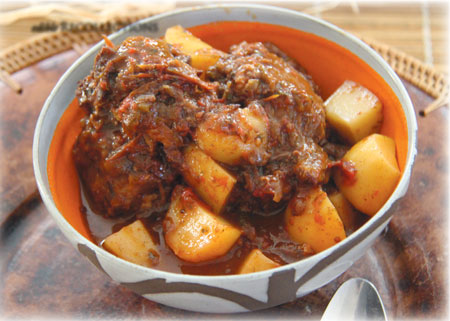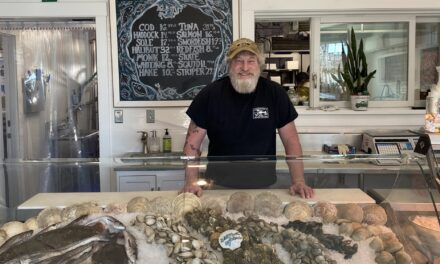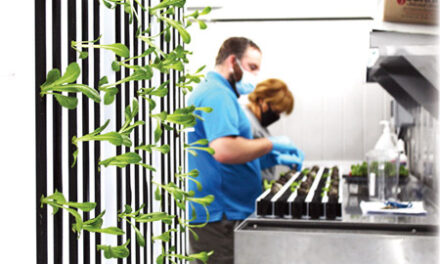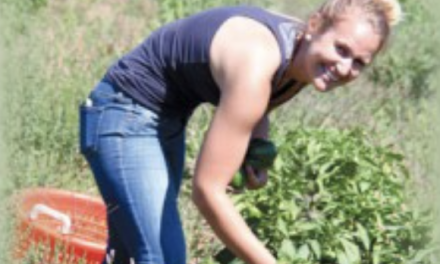Words and prose by Pamela Denholm.

Recipes need to be shared to be remembered, or they’ll be forgotten for good.
Hey, come on in, pull up a seat. Coffee is on. I’m making oxtail stew. This dish takes me back to when we lived in Rhodesia—well, that’s what it was called back then, it was a British colony. No, I am not super old, I’m in my forties! I know, I know, everybody always assumes colonies happened two hundred years ago. “How old are you?” That’s the first thing they ask. We moved from Rhodesia before it declared its independence and became Zimbabwe, to apartheid South Africa, just in time for me to start school—that’s a long story for another day.
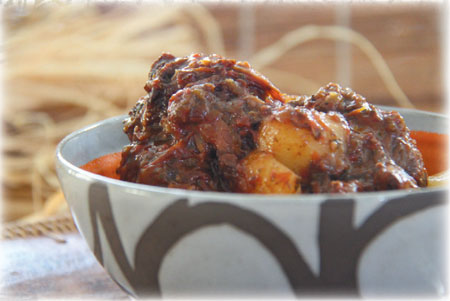
Liz Kinder’s distinctive wax-resist brushwork decoration and bright glazes on a stoneware bowl. Available at Local Pottery, Norwell.
Okay, so first, you’ll want more oxtail than you need, because—leftovers. About 4 lbs should do it. Put the oxtail in a bowl with salt, pepper, and flour, and toss until well coated. A little personal background as we cook; we weren’t alone in this adventure, the move, I mean. We ended up with pockets of Rhodesian-slash-Zimbabwean communities all over South Africa. The South Africans called us “When We’s” because living in Rhodesia was a grand time, and we were always “remember when we did this,” or “remember when we did that.” It was very annoying to the South Africans, apparently. I suppose it must have been like sitting through a long slideshow of someone else’s exciting holiday photos.
Could you pass the oil? We’ll pop this oxtail in the hot frying pan, turning it until it’s browned on all sides, then we will take it out of the pan and brown the onions—that way we get all the pan scrapings. Remembering is a very special thing though, don’t you think? Especially as we get older. Who our teachers were, places we visited that might no longer exist? “You can never step into the same river twice.” Heraclitus said that. I love a good quote, and that one will stay with you for days. Music, now that’s something that will take you back. And food. Goodness, one whiff of cinnamon and you are back in Grandma’s kitchen, or at the Thanksgiving table.
We’ll use a slow cooker (or crockpot) for this recipe. Plug it in, won’t you? Right, next we want to put a layer of browned oxtail and onions on the bottom, sprinkle generously with Worcestershire sauce—I like the Lea & Perrins one, that comes wrapped in paper. Add a splash of red wine—any cooking wine will do. We had a family friend who made wine. He gave us bottles for the table that were only fit for the pot. Add a layer of chopped tomatoes, then oxtail, Worcestershire sauce, wine, tomatoes, do this until we use up all the ingredients. Add the cloves and herbs last. I don’t know why we don’t just budza the whole lot in a pot and turn it on. I suppose we could, but Aunty Anne swears by doing it this way. Set it to cook for eight hours. I’ll pour another coffee, there are some biscuits and rusks in that tin on the top shelf, why don’t you get it down?

Pam and her parents, Joanne and Dion Le Roux. The above photo was taken from the west bank of the Goukou River in Stillbay which is in the Western Cape.
You know, I’ve lived in the United States for 12 years now. I moved with my husband, so you can say I came for love. “What brought you here?” That’s the first thing everybody asks when they hear my accent. Old home. That’s what we call South Africa now, since here is also home. When you trade one cultural construct for another it’s an adjustment. For instance, we don’t eat the same things here as we did there, obviously. All it takes is the smell of a good curry, and I’m transported. Or freshly ground coriander, or . . . well, let’s just leave it there.
Did you know I went back to see my mom and dad at the end of last year? Thirty-six hours travelling, door-to-door. To pass the time I made a list of all my favorite South African foods I wanted to squeeze in during my trip. Pickled Fish. Boerewors. Melktert. Crunchies. My dad, being both handsome and smart, met me at the airport with a packet of biltong and a Grapetizer. Check, and check, our stroll down gastronomic memory lane had begun on touchdown. One special item loomed large on my list: my mom’s recipe for oxtail. My husband, Mark, can’t eat it, it’s too rich, so I don’t have the occasion to cook it very often—which is why I’m so glad you are here today. This will be a treat. One of the reasons for my trip back home, was that my mom had recently been diagnosed with dementia. I didn’t tell you? Well, it’s hard news to receive about somebody you love. Harder still when you don’t live on the same continent. I may be spared witnessing her slow spiral into confusion, but I’m also not there for these precious years where it’s mostly good days, and I would pay just about any price for every single one of my mom’s good days.
My mom could sense me assessing where she was on the sliding dementia scale. It was hard not to; I hadn’t seen her since the diagnosis. I was worried, but it made her self-conscious, so I cut it out and just tried to live in each moment. We enjoyed long walks, which was wonderful because we both used to love hiking. We put aside 1000-piece jigsaw puzzles, and on rainy days settled in to 500-piece puzzles instead. I listened to as many stories as my mom would tell, some of them over and over again, and when we cooked dinner or did any baking, my dad and I did most of the heavy lifting because following anything but a simple recipe caused my mom too much stress.
My mom has always been a capable cook. She cooked dinner almost every night, we never ate anything from a box and only ate out on very special occasions. When my sister and I moved out my mom gave us each a recipe book with all our family favorites. Her chocolate cake recipe, which my mom baked every year for all of our birthdays, was on the first page. It’s still my favorite cake, we never tire of it. Tipsy Tart, a pudding made with hot brandy and dates and served with cream at Christmas, my dad’s special lamb curry cooked in a cast iron pot (over a fire is best, but stove top will work too), and my mom’s meat pie. Nobody makes a meat pie like my mom. All these recipes are housed in this much-treasured little book, except for the one for my mom’s oxtail. That one existed only in my mom’s head.
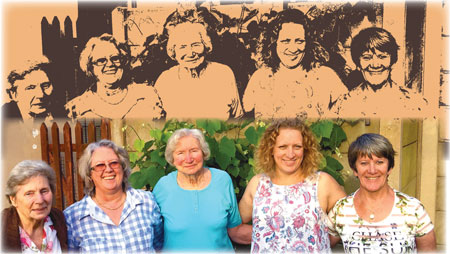
Aunty Beryl, Aunty Anne, Aunty Myrtle (Aunty Beryl’s sister), Pamela Denholm (the author), Pamela’s mother Joanne.
When the slow cooker has been on for about four hours, we just want to check on it, maybe adjust the seasoning, add more Worcestershire sauce and wine. At hour six we will turn it off and allow it to cool. Aunty Anne says sometimes she will do this first part the day before and allow it to cool overnight. When the pot is cool, we will scrape all the fat from the top and save it for something else. Oxtail is very fatty; that’s what makes the dish so rich. That, and the gelatin in the bones— which is one of the reasons people are always telling you to make your own stock from scratch—and why you don’t need to add stock to this dish, it’s a twofer. Then, we’ll want to add potatoes, salt, pepper, and more Worcestershire sauce, and cook it for another two hours.
Anyway, back to my mom. You know, dementia is an unreliable thing, what’s lost doesn’t stay lost until it does. My mom, who is the kindest person you will ever meet, is fighting, hard. She does crossword puzzles. She works at staying in the present and gets very upset when she can’t. It’s hard for my dad too, I can see how it weighs on him. I wish with all my heart we lived closer. It was when Aunty Anne, who is actually my dad’s cousin, visited one afternoon and we were talking about how much I was enjoying my visit that I asked my mom if we could make oxtail for dinner one night. My mom couldn’t remember when last she’d made it and wasn’t sure she would remember how, but the matter was quickly settled—we were all to come to Aunty Anne’s house for oxtail dinner that Friday. Aunty Anne graciously insisted.
Memory, if you have it, is also an unreliable thing. A tune or a smell can make 20 years ago seem like yesterday, and most memories are golden, sepia-toned. Ever notice that? It raises your expectations. Hey, let’s switch coffee for wine, dinner won’t be long now. I did wonder, had I hyped up the oxtail in my head? It wasn’t my mom’s recipe, so maybe it wouldn’t be the same. That could be, but the smells greeting us on arrival at Aunty Anne’s were promising. They have a great house. The story goes that it was built for my great-grandfather in the exact same layout as their house on the farm in Namibia. He was going blind and so when he retired back to Stillbay in South Africa with my great-grandmother, they wanted to make sure he could find his way around. We gathered at Aunty Anne’s kitchen table with her husband, Herman, and her mom, my Great-Aunt Beryl, and we dished up. Gosh, it was one of the best oxtail dishes I have had. Every bit as good as I remembered, and Aunty Anne even gave me the recipe.
Oh good, that’s the timer. Smell that? See how nice and thick the gravy is? You’ll want to keep the sides simple, rice, green beans, carrots—that sort of thing. Tomorrow, you can heat the leftovers for lunch. Dunk a hunk of fresh bread into the gravy, so good. “So, what is oxtail and where do you get it?” People always ask that. Well, it is the tail bones of an ox, or steer, or cow. It’s beef. You wouldn’t think there’d be much meat on there, but you’d be surprised. I sometimes see it in the grocery stores, and you can buy it from anyone who raises their own beef. It’s old-fashioned and I don’t know why it has fallen out of favor, probably because it takes so long to cook, but what is old is new again eventually, and things need to be shared to be remembered, or they’ll be forgotten for good. Next time, if you like, we can make curried pickled fish. It’s great in the summertime because it’s best served cold. Or maybe you could share one of your family favorites? I’d like that.
Here’s the author’s Oxtail Stew recipe, step-by-step: recipe here.
Ask your local farmer listed below about oxtail availability.
This nicely butchered oxtail was knife-cut, respecting the vertebrae, not band-sawn. Also, inquire at any local grocery store with in-house butchering.
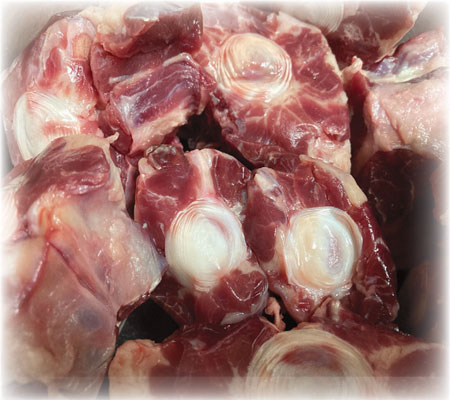
Photos: Mike Race
Meat Farmers:
Weatherlow Farms
845 Sodom Road, Westport, MA 02790
www.WeatherlowFarms.com
Dufort
55 Reservoir Avenue, Rehoboth, MA 02769
www.DufortFarms.com
J&L Beaulieu Farm Stand
151 Alden Road, Fairhaven, MA 02719
www.JoeBeaulieuFarm.com
Stonycreek Farm
1210 Wilbur Avenue, Swansea, MA 02777
www.Facebook.com/StonyCreekFarmandGrassFedBeef
WAG the COW!
Why does oxtail make the most luxurious, even voluptuous, broth? Anyone who has ever hand-milked a cow probably gets it. When the back of your head is on the receiving end of a tail-swish and you come close to seeing stars, you deeply appreciate the power locked up in that innocent-looking bovine-appendage. With little apparent effort, your girl lashes her amazingly strong yet supple tail to whisk flies from her flanks—and, if she can, cunningly whaps you upside the head at least once or twice per session.
A look at the anatomy of the tail reveals why it is so strong, and at the same time, why it makes such delectable food when cooked low and slow. A narrowing series of 18-20 vertebrae, fitting together like a 3-D puzzle, extends from the cow’s sacrum, strung together with tendons, ligaments and strips of muscle. In life this compact structure is covered in stout cowhide (what else?) and tipped with a fetching tassel of long coarse hair. Upon butchering, the tail is commonly trimmed to leave the two largest vertebrae with the pelvic part of the carcass, and then cut or sawn into sections.
That intricate construction, those materials, provide the best scenario for long slow braising—terrific flavor and structure ready to be unlocked over the period of hours into a supremely gelatinous and savory dish. And what about the name? An ox means a castrated male bovine, formerly very common work animals—therefore common food, too. Because tails always require long cooking, butchers were happy to acknowledge the maturity of the animal when marketing the cut. In fact, given the long and widespread adherence to the “you are what you eat” maxim, the notion of making a comforting, strengthening dish out of a huge animal associated with strength and endurance sells itself. Nowadays, bovine tail is always marketed as oxtail, regardless of the sex or intactness of the animal that sported it in life.
-PM

